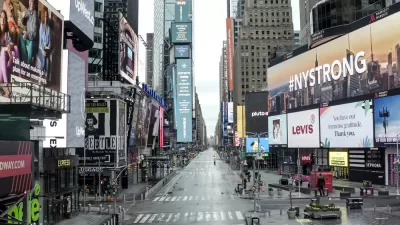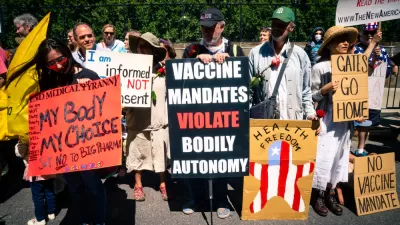Modular systems and flexible use of shared spaces are priorities as urban designers begin to consider how design requirements will change in the future.

Efforts to slow the spread of the coronavirus are prompting creative, life-saving design interventions. The past few months have seen the repurposing of buildings and even shipping containers as medical facilities and the retrofitting of hospitals to facilitate distancing. In the coming months and years, schools and offices will be redesigned to meet social distance protocols.
According to Starr Herr-Cardillo, "many of the pandemic’s most enduring influences over the built environment won’t be felt during the pandemic itself. They will evolve over the next several months and years." Architects, not typically considered to be first responders, are spearheading design interventions that will have a lasting impact on the built environment.
In Philadelphia, the Community Design Collaborative’s Design SWAT team, a design collaborative offering pro-bono design services to community organizations redesigned the local Sunday Breakfast Rescue Mission to include handwashing stations, repurposing the dining hall as a "functional multi-purpose room."
Architects predict that modular systems and flexible use of spaces will be key as retrofits and redesigns are prompted as a coronavirus response. Research is underway and it is possible that "careful evaluation across institutions might help identify those small, innocuous-but-critical design factors that made a difference."
FULL STORY: How designers are remaking spaces for our new socially distanced lives

Study: Maui’s Plan to Convert Vacation Rentals to Long-Term Housing Could Cause Nearly $1 Billion Economic Loss
The plan would reduce visitor accommodation by 25,% resulting in 1,900 jobs lost.

North Texas Transit Leaders Tout Benefits of TOD for Growing Region
At a summit focused on transit-oriented development, policymakers discussed how North Texas’ expanded light rail system can serve as a tool for economic growth.

Using Old Oil and Gas Wells for Green Energy Storage
Penn State researchers have found that repurposing abandoned oil and gas wells for geothermal-assisted compressed-air energy storage can boost efficiency, reduce environmental risks, and support clean energy and job transitions.

From Blight to Benefit: Early Results From California’s Equitable Cleanup Program
The Equitable Community Revitalization Grant (ECRG) program is reshaping brownfield redevelopment by prioritizing projects in low-income and environmental justice communities, emphasizing equity, transparency, and community benefits.

Planting Relief: Tackling Las Vegas Heat One Tree at a Time
Nevada Plants, a Las Vegas-based nonprofit, is combating the city’s extreme urban heat by giving away trees to residents in underserved neighborhoods, promoting shade, sustainability, and community health.

How Madison’s Tree Planting Efforts Are Growing a Healthier Community
Madison’s annual tree planting initiative is enhancing environmental resilience, public health, and community livability by adding 1,400 carefully selected trees citywide, with strong community and institutional support for urban forestry.
Urban Design for Planners 1: Software Tools
This six-course series explores essential urban design concepts using open source software and equips planners with the tools they need to participate fully in the urban design process.
Planning for Universal Design
Learn the tools for implementing Universal Design in planning regulations.
Ascent Environmental
Borough of Carlisle
Institute for Housing and Urban Development Studies (IHS)
City of Grandview
Harvard GSD Executive Education
Toledo-Lucas County Plan Commissions
Salt Lake City
NYU Wagner Graduate School of Public Service





























